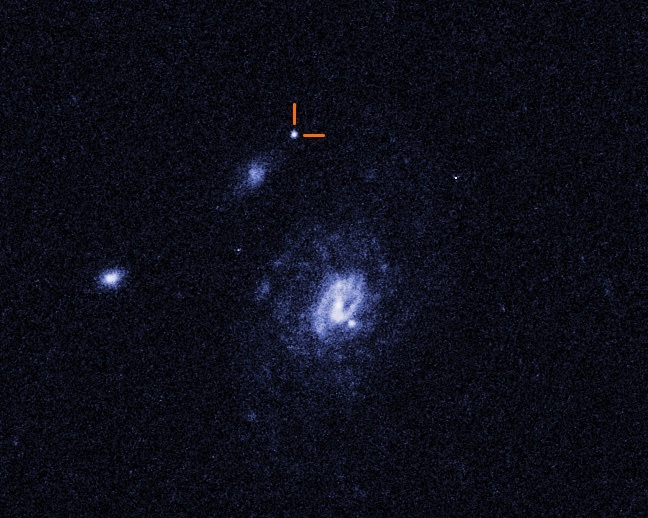A very rare, strange burst of extraordinarily bright light in the universe just got even stranger – thanks to the eagle-eye of NASA's Hubble Space Telescope.
6.10.2023

The phenomenon, called a Luminous Fast Blue Optical Transient (LFBOT), flashed onto the scene where it wasn't expected to be found, far away from any host galaxy. Only Hubble could pinpoint its location. And, the results are leaving astronomers even more confounded. To start with, they don’t know what LFBOTs are. The Hubble results suggest they know even less by ruling out some possible theories.
LFBOTs are among the brightest known visible-light events in the universe – going off unexpectedly like camera flashbulbs. Only a handful have been found since the first discovery in 2018 – an event located about 200 million light-years away that was nicknamed "the Cow." Presently, LFBOTs are detected once per year.
After its initial detection, the latest LFBOT was observed by multiple telescopes across the electromagnetic spectrum, from X-rays to radio waves. Designated AT2023fhn and nicknamed "the Finch," the transitory event showed all the tell-tale characteristics of an LFBOT. It shined intensely in blue light and evolved rapidly, reaching peak brightness and fading again in a matter of days, unlike supernovae, which take weeks or months to dim.
But unlike any other LFBOT seen before, Hubble found that the Finch is located between two neighboring galaxies – about 50,000 light-years from a nearby spiral galaxy and about 15,000 light-years from a smaller galaxy.
"The Hubble observations were really the crucial thing. They made us realize that this was unusual compared to the other ones like that, because without the Hubble data we would not have known," said Ashley Chrimes, lead author of the Hubble paper reporting the discovery in an upcoming issue of the Monthly Notices of the Royal Astronomical Society (MNRAS). He is also a European Space Agency Research Fellow, formerly of Radboud University, Nijmegen, Netherlands.
While these awesome explosions have been assumed to be a rare type of supernova called core-collapse supernovae, the gargantuan stars that turn into supernovae are short-lived by stellar standards. Therefore, the massive progenitor stars don't have time to travel very far from their birthing place – a cluster of newborn stars – before exploding. All previous LFBOTs have been found in the spiral arms of galaxies where star birth is ongoing, but the Finch is not in any galaxy.
"The more we learn about LFBOTs, the more they surprise us," said Chrimes. "We've now shown that LFBOTs can occur a long way from the center of the nearest galaxy, and the location of the Finch is not what we expect for any kind of supernova."
The Zwicky Transient Facility – an extremely wide-angle ground-based camera that scans the entire northern sky every two days – first alerted astronomers to the Finch on April 10, 2023. Once it was spotted, the researchers triggered a pre-planned program of observations that had been on standby, ready to quickly turn their attention to any potential LFBOT candidates that arose.
Spectroscopic measurements made with the Gemini South telescope in Chile found that the Finch is a scorching 36,000 degrees Fahrenheit. Gemini also helped determine its distance from Earth so its luminosity could be calculated. Together with data from other observatories including NASA's Chandra X-ray Observatory and the National Science Foundation's ground-based Very Large Array radio telescopes, these findings confirmed the explosion was indeed an LFBOT.
The LFBOTs could be the result of stars being torn apart by an intermediate-mass black hole (between 100 to 1,000 solar masses). NASA's James Webb Space Telescope's high resolution and infrared sensitivity might eventually be used to find that the Finch exploded inside a globular star cluster in the outer halo of one of the two neighboring galaxies. A globular star cluster is the most likely place an intermediate-mass black hole could be found.
To explain the unusual location of the Finch, the researchers are considering the possibility that it is the result of a collision of two neutron stars, travelling far outside their host galaxy, that have been spiraling toward each other for billions of years. Such collisions produce a kilonova – an explosion 1,000 times more powerful than a standard nova. However, one very speculative theory is that if one of the neutron stars is highly magnetized – a magnetar – it could greatly amplify the power of the explosion even further to 100 times the brightness of a normal supernova.
"The discovery poses many more questions than it answers," said Chrimes. "More work is needed to figure out which of the many possible explanations is the right one."
Because astronomical transients can pop up anywhere and at any time, and are relatively fleeting in astronomical terms, researchers rely on wide-field surveys that can continuously monitor large areas of the sky to detect them and alert other observatories like Hubble to do follow-up observations.
A larger sample is needed to converge on a better understanding of the phenomenon, say researchers. Upcoming all-sky survey telescopes, such as the ground-based Vera C. Rubin Observatory, may be able to detect more, depending on the underlying astrophysics.
Quelle: NASA
